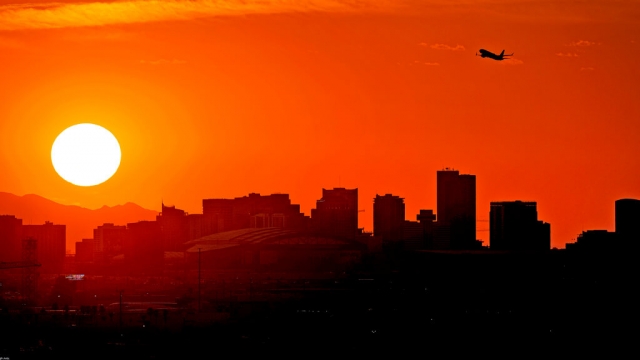Temperatures of 110 degrees or more could stick around Phoenix through the end of the month, according to NOAA. The extreme heat is driving up energy demand, putting the power grid to the test, and pushing Arizonans to the brink.
"As our climate warms, we're just going to continue to see the probability of breaking these warm records," NOAA Phoenix Meteorologist Mark O’Malley said.
The intensifying heat is shattering records this summer in Arizona and across the United States.
The Maricopa County Department of Emergency Management wanted to show people just how hot it is outside by placing a pizza on a vehicle dashboard. In ten minutes, the cheese began to melt, and within 90 minutes, the pie was cooked.
On Tuesday, Phoenix surpassed the 18-day record set in 1974 of 110 degrees or more in a row. The average temperatures at night remain in the 90s.
People in need of a break from the extreme heat lined up outside the Brian Garcia Welcome Center in downtown Phoenix. The nonprofit is the first point of contact to connect people with resources, but in the blistering heat, it has become a cooling center.
Human Services Campus CEO Amy Schwabenlender said she believes it’s the only cooling shelter in Maricopa County open 24/7.
Forecasts show no relief in sight, and it worries Schwabenlender, who said there are not enough shelters to accommodate the thousands of people who live on the streets.
"The more days like this, the harder it becomes for people to stay healthy and safe; my biggest concern is that more people will die," Schwabenlender said.
A study published by the journal Environmental Science & Technology titled "How Blackouts during Heat Waves Amplify Mortality and Morbidity Risk" found a multiday power grid blackout during a heat wave would more than double the estimated heat-related deaths across Phoenix, Detroit, and Atlanta, and more than 50% of the Phoenix population would require medical attention.
SEE MORE: Phoenix sets record at 19th straight day of at least 110 degree temps
"Several thousand could be expected to die in the event, again, of this significant power outage," Evan Mallen, a senior analyst with Georgia Tech’s Urban Climate Lab and a study contributor, said.
The report also found an increase in electrical grid failures, also known as blackout events, in the United States. The number of blackouts lasting more than an hour and impacting more than 50,000 customers more than doubled between 2015–2016 and 2020–2021. The study found most outages happened during the summer months, when demand increased.
On July 15, when Phoenix hit 118 degrees, Arizona Public Service (APS), the largest energy company in the state, shattered the record demand for energy, topping out at nearly 8,200 MW. The most electricity used at once in APS history.
Just two days earlier, on July 13, ERCOT, an energy company providing service to 90% of Texas, set an unofficial energy demand record of 81,000 MW.
"The higher the temps, the higher the load," APS Vice President of Resource Management Justin Joiner said.
APS invests more than $1.5 billion to maintain and upgrade the grid with new technology.
Joiner said their investment in technology and future forecasting helps prepare them for the long stretches of heat waves. APS traders work around the clock, buying and selling energy to other states based on the weather forecast and customer demand.
"We are prepared because we’ve done the maintenance, we’ve done the investment, we’ve done the proactive planning," Joiner said.
As other cities experience hotter summers and power grids are pushed to the brink, Joiner hopes to provide a blueprint for how energy companies should operate.
Earlier this year, the North American Electric Reliability Corporation warned that two-thirds of North America was at risk of energy shortfalls this summer during periods of extreme demand.
Extreme heat causes more deaths than flooding or hurricanes. In 2022, the Maricopa County Department of Public Health reported 425 heat-associated deaths, a 25% increase from 2021.
David Hondula, the director of heat response and mitigation for the city of Phoenix, said looking at federal documents, it’s clear that plans to deal with heat are "underdeveloped" compared to other hazards.
He adds that dealing with intense heat requires additional planning and support from FEMA.
Trending stories at Scrippsnews.com




